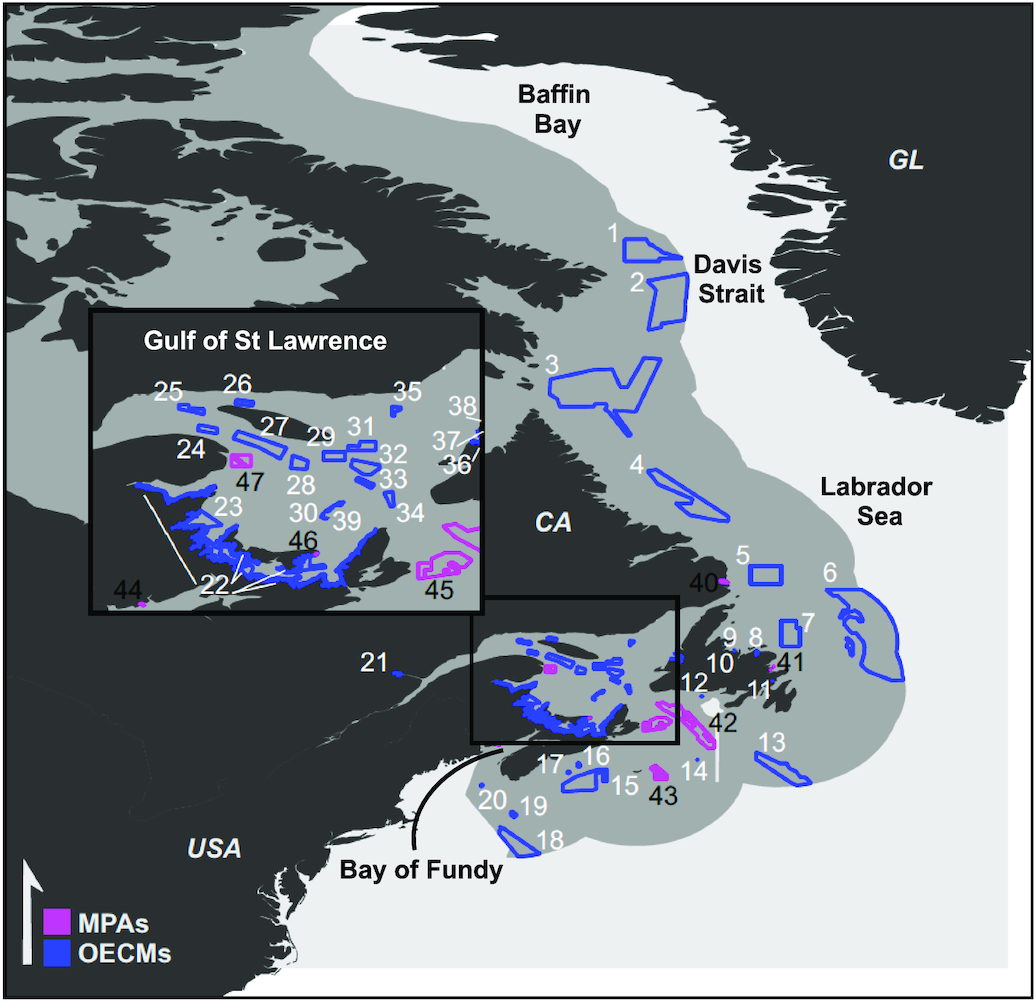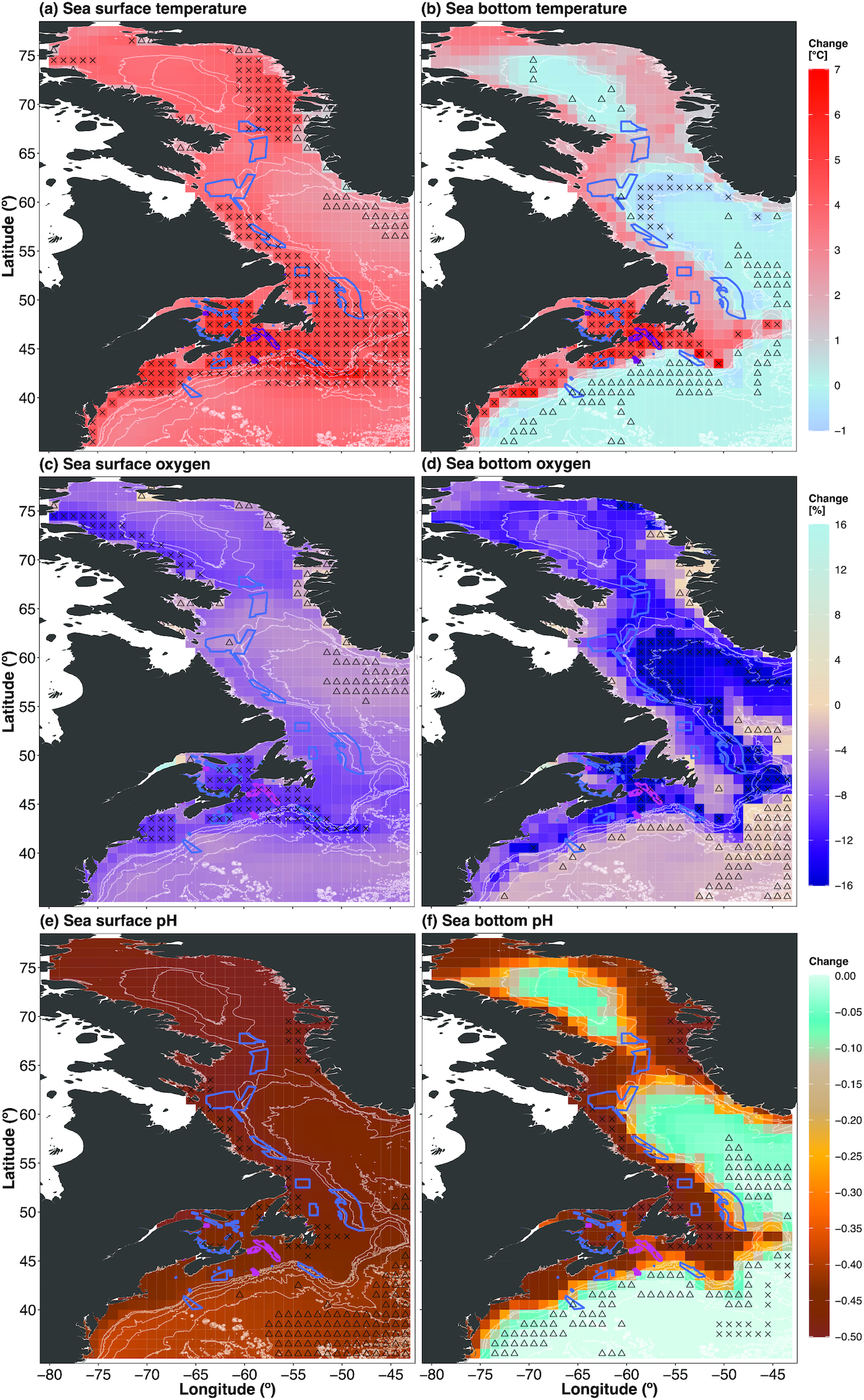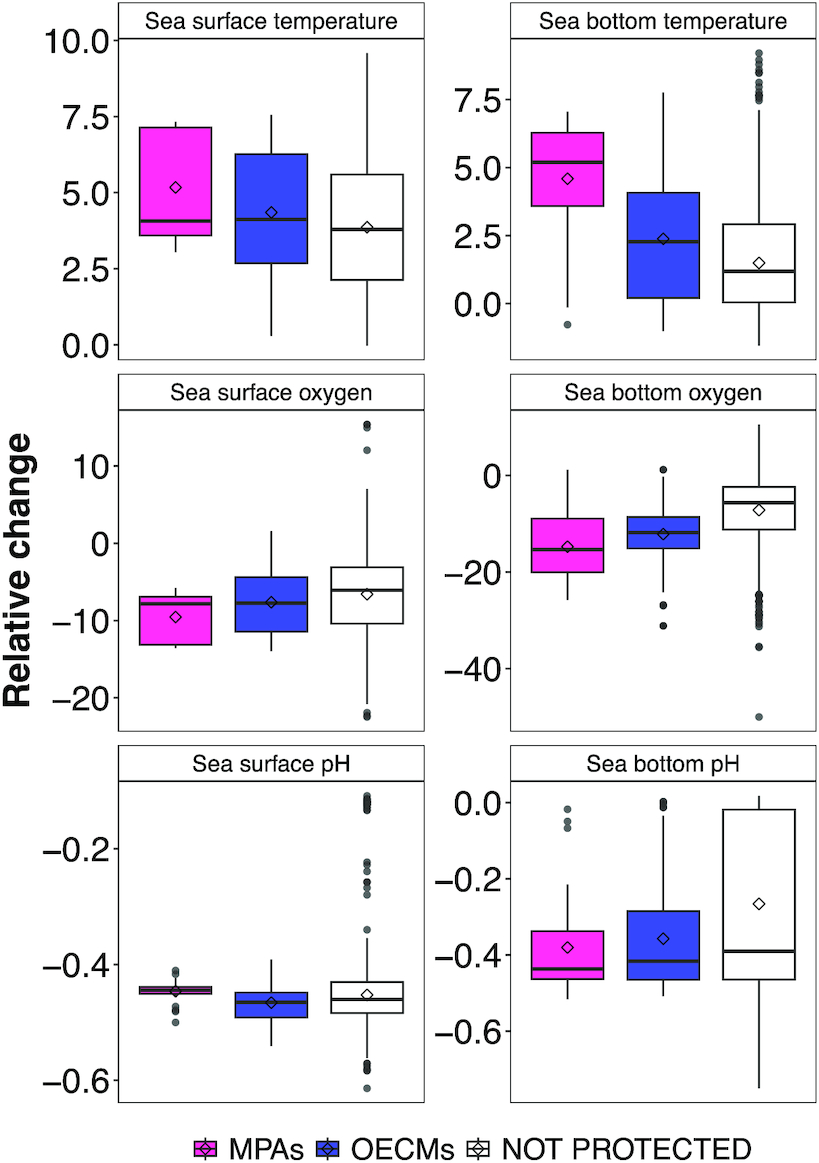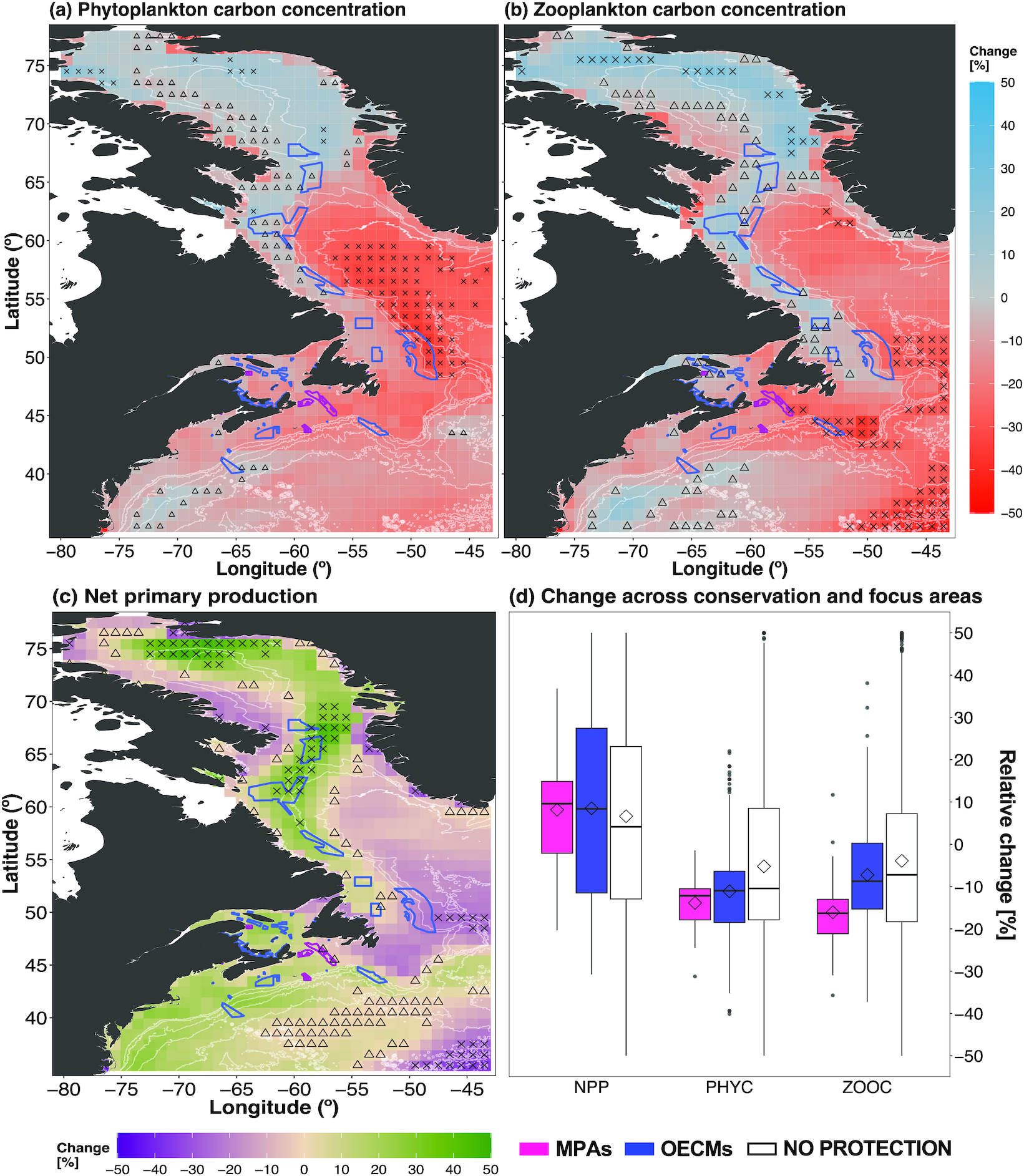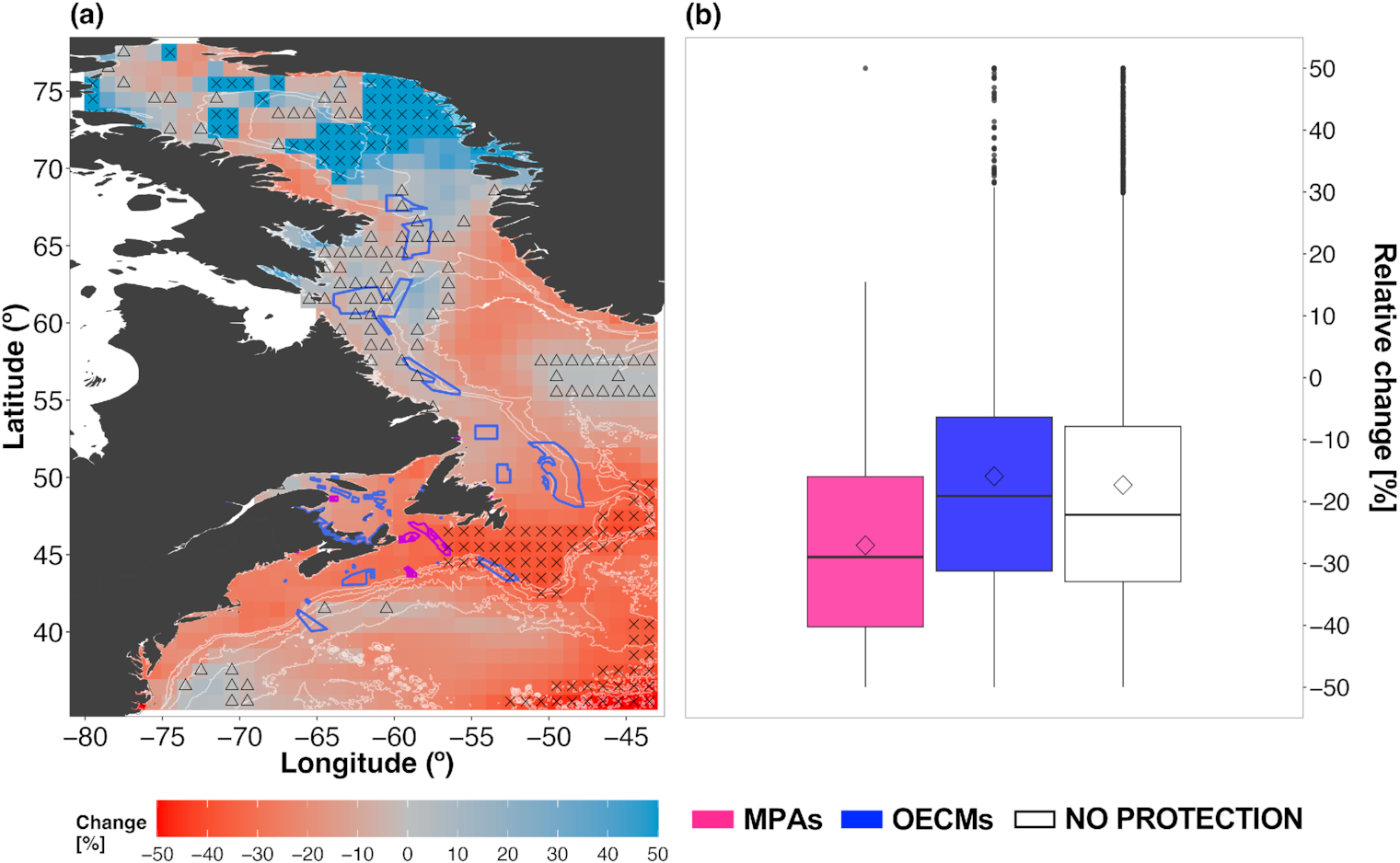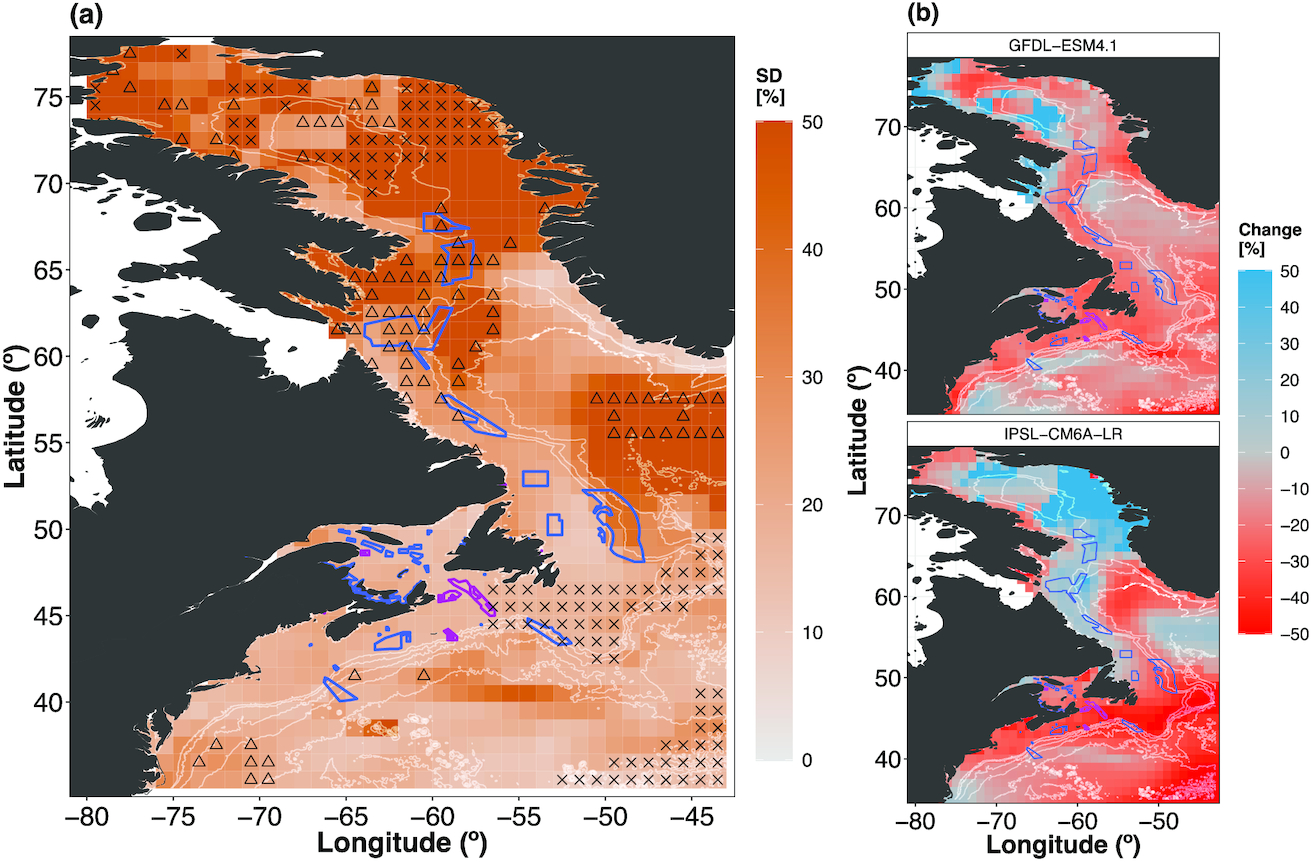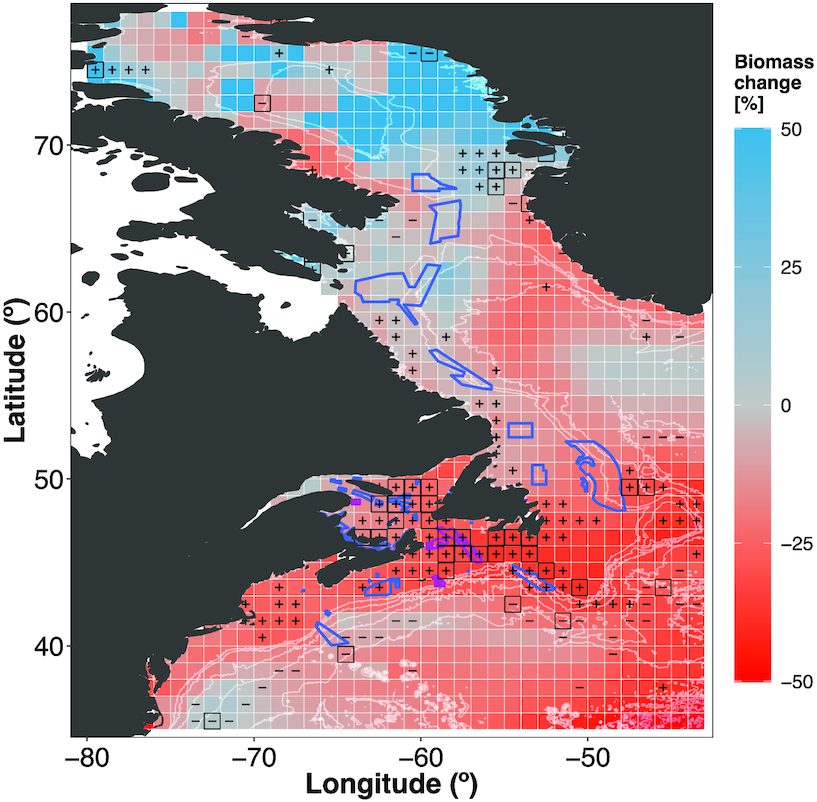Introduction
Marine biodiversity and ocean ecosystems are already altered by climate change on local to global scales, and these impacts are projected to increase over the 21st century and beyond. Observed impacts of climate change include the expansion, contraction or shift of species ranges (e.g.,
Nye et al. 2009;
Poloczanska et al. 2013;
Orio et al. 2019), shifting phenology (e.g.,
Parmesan and Yohe 2003;
Dufour et al. 2010;
Poloczanska et al. 2013;
Langan et al. 2021), and changes in depth distributions (e.g.,
Dulvy et al. 2008), changes in metabolism (
Pörtner and Knust 2007), species composition and abundance (e.g.,
Hastings et al. 2020;
Pershing et al. 2021;
Gordó-Vilaseca et al. 2023), species interactions (e.g.,
Grady et al. 2019), and trophic transfer efficiency (
Barneche et al. 2021;
Eddy et al. 2021), all of which affect ecosystem structure, functions, and services to human well-being (
Bindoff et al. 2019;
Pershing et al. 2021). Moreover, climate change can undermine the effectiveness of fisheries management and marine conservation efforts (e.g.,
Pershing et al. 2015;
Tittensor et al. 2019;
Wilson et al. 2020;
Lotze 2021). However, integration of climate change adaptation, mitigation, and resilience into marine conservation planning and management is limited both in Canada and elsewhere (
Bryndum-Buchholz et al. 2022;
O'Regan et al. 2021). At present, only 26% of Canadian MPAs consider climate change in their design, monitoring, or management (
O'Regan et al. 2021).
Currently, Canada is working towards fulfilling its national target and international commitment to marine conservation by protecting 25% of its ocean area by 2025 and 30% by 2030 (
DFO 2021). To achieve this, Canada is continuing to grow its network of marine conservation areas, including
Oceans Act Marine Protected Areas (MPAs) and
Fisheries Act Other Effective area-based Conservation Measures (OECMs), across its three oceans (
DFO 2021). At the time of writing, about 800 marine conservation areas encompassing 13.9% of the exclusive economic zone (EEZ) and 798,861 km
2 have been established within Canadian waters (
Government of Canada 2022). Of these, ∼2% are MPAs and ∼7% OECMs (
Government of Canada 2022), representing 80% of the area protected by some form of marine conservation measure in Canada (
Bryndum-Buchholz et al. 2022). Other spatial marine conservation measures in Canada are managed by provincial and territorial governments (1% Marine Conserved Areas), Environment and Climate Change Canada (4% National Wildlife Areas and Bird Sanctuaries), and Parks Canada (15% National Park Reserves and National Marine Conservation Areas) (
Government of Canada 2022).
Although all of Canada's oceans will be affected by climate change (
Bryndum-Buchholz et al. 2020), the Northwest Atlantic in particular is considered a climate change hotspot, with average rates of projected warming two times higher than the global average (
Pershing et al. 2015;
Saba et al. 2016). This is largely due to the high sensitivity of the area to changes in the strength and position of the Labrador Current System and the Gulf Stream, which strongly influence oceanographic conditions (
Richaud et al. 2016;
Gonçalves Neto et al. 2021) and ecological communities (
Lotze et al. 2022). Generally, climate and oceanographic conditions in Atlantic Canada have been quite stable over the past 4000 years until a clear warming trend began in the 1960s (
Lotze et al. 2022). This recent warming, together with associated changes in other oceanographic conditions (e.g., increase/decrease in primary production, acidification, deoxygenation, sea level rise, and increasing frequency of marine heatwaves), adds to impacts from fishing pressure, habitat alterations, pollution, and other human activities (
Halpern et al. 2008,
2015). The combined effects of these factors have contributed to rapid changes at all trophic levels of the marine ecosystem, bringing new challenges to marine management and conservation efforts (
Lotze et al. 2022).
To ensure effective long-term marine conservation planning, climate change impacts need to be considered as an integral part of planning and management frameworks. Marine conservation agencies can make use of short- and long-term projections of climate-induced population- or ecosystem-level changes to inform management plans. One approach to projecting climate change impacts on marine ecosystems is to use an ensemble of marine ecosystem models (MEMs) forced by Earth system models (ESMs), which provide a range of physical and biogeochemical conditions under different climate change scenarios (
Séférian et al. 2020), to project future changes in marine ecosystems (
Tittensor et al. 2018a,
2021). Individual ESMs and MEMs adopt different structures and representations of oceanographic and ecological processes, respectively (
Heneghan et al. 2021). Combining outputs from MEMs into model ensembles allows for the quantification of mean trends and estimates of uncertainty in projected changes due to differences in, e.g., model structure, numerical implementations, and parameterizations, in the ESMs and MEMs (
Mora et al. 2013;
Tittensor et al. 2018a,
2021). Such ensemble projections have become the gold standard in the climate change projection and impact sciences as they provide more reliable outcomes than any individual model (e.g.,
Eyring et al. 2016;
Exbrayat et al. 2018;
Tittensor et al. 2018a,
2021;
Lotze et al. 2019;
Dankers and Kundzewicz 2020;
Tokarska et al. 2020).
Here, we analyze future trajectories of climate change impacts on marine animal biomass and key environmental drivers across the Northwest Atlantic Ocean and evaluate the consequences for existing MPAs and OECMs in Atlantic Canada. For this initial effort, we focused on one conservation management agency, and the other Canadian marine conservation measures were not included. Specifically, we identify single-factor and cumulative climate change hotspots and refugia in terms of rates of change in total consumer biomass and key environmental drivers. In marine conservation planning, climate hotspots are areas where climate impacts are likely to affect marine ecosystems more rapidly, requiring climate-change adaptations. Climate refugia can indicate locations that may be less susceptible to expected future climate change impacts, and hence can be priorities for future marine conservation areas if they are simultaneously biodiversity-rich (
Keppel et al. 2012;
Ban et al. 2016). While climate refugia can play an important role in future-proof marine conservation planning, future conservation efforts should ideally consider a range of vulnerabilities, protecting a seascape that can protect a range of possible ecosystem responses (
Tittensor et al. 2019;
Bryndum-Buchholz et al. 2022).
We used results from the newest simulation round of the Fisheries and Marine Ecosystem Model Intercomparison Project (Fish-MIP;
Tittensor et al. 2018a,
2018b,
2021), which provides standardized outputs of total consumer biomass from nine global MEMs driven by two ESMs from the 6th Coupled Model Intercomparison Project (CMIP6) under a high-emission scenario (SSP5-8.5), as well as the results of these two ESMs in terms of ocean temperature, oxygen content, pH levels, net primary production, and phytoplankton and zooplankton carbon concentration (ZOOC). Our results can provide important long-term context to help inform marine biodiversity conservation planning and decision-making in a rapidly changing ocean.
Discussion
Our results suggest that marked climate change effects on marine ecosystems are to be expected in the Northwest Atlantic Ocean throughout the 21st century and that these will have consequences for biodiversity conservation planning within the region. Indeed, our analysis revealed that no MPA or OECM in the Canadian EEZ overlaps with cumulative climate refugia, whereas most (75%) established MPAs and more than one third (39%) of the established OECMs lie within cumulative climate hotspots. This evidence suggests that, if greenhouse gas emissions follow the SSP5-8.5 trajectory, current MPAs and OECMs in Atlantic Canada will likely need to be re-evaluated and adaptively managed to fulfill their current or revised future conservation goals. Protected areas with more broadly defined conservation priorities (e.g., biodiversity conservation) than the ones in focus here may be less affected by drastic environmental changes as long as broader regional or national conservation targets are being met and other stressors (e.g., fishing, oil and gas extraction) are avoided or minimized.
The Northwest Atlantic is warming at a higher rate than the global average and can act as a herald of future climate change effects on marine ecosystems and associated biodiversity conservation planning in Canada and beyond. By the end of the 21st century, projected SST and SBT had increased throughout the focus region, with the coast of the Canadian Maritimes and Maine showing the highest values. These projected physical changes, and their associated uncertainties in both magnitude and direction, are alarming, since the most affected regions are important habitats for commercially important groundfish species (e.g., Atlantic cod (
Gadus morhua)
, haddock (
Melanogrammus aeglefinus), turbot (
Scophthalmus maximus)), the American lobster (
Homarus americanus), and snow crab (
Chionoecetes opilio) (
Castañeda et al. 2020;
DFO 2022). For some of those species, OECMs are in place to protect spawning habitats, stock productivity, and nursery areas (e.g., Haddock Box, Gander Bay Lobster Closure, Hawke Channel Closure; Table S1), which may become ineffective.
While projections of PHYC and ZOOC largely agree in the direction of change across the two ESMs, with the exception of areas in northern Baffin Bay, NPP projections disagree. For example, where GFDL-ESM4.1 projects NPP decreases in the Gulf of St. Lawrence, Davis Strait, and northern Baffin Bay, IPSL-CM6A-LR projects large increases. NPP projections are considered to have substantial uncertainties in the CMIP6 ESM ensemble on a global scale (
Bopp et al. 2022). Additionally, for ESM projections in Arctic latitudes, where data can be scarce and coastal dynamics difficult to capture (e.g., sea-ice dynamics, biases in Arctic deep water temperature and salinity representation;
Khosravi et al. 2022), add another layer to the projection uncertainty. Hence, our results for the northern areas of the focus region should be interpreted with these sources of uncertainty in mind.
The simulated physical and biogeochemical changes are driving TCB changes in MEM simulations. Our MEM ensemble largely projects that marine biomass decreases in the southern, more temperate regions, and increases largely in the polar and subpolar latitudes. All fully established MPAs in Atlantic Canada were located within hotspots of TCB decreases for end-century projections under SSP5-8.5 (50% for mid-century projections). Those projected changes can be expected to be of lesser magnitude under SSP1-2.6, highlighting the importance of implementing effective climate change mitigation policies (
Tittensor et al. 2021). OECMs located along the Labrador and Baffin Island coasts were largely located within refugia of biomass changes, whereas OECMs south of Newfoundland and on the Scotian Shelf were in hotspots of TCB changes (
Figs. 1 and
5a and S22).
OECMs located along the Labrador and Baffin Island coasts did not overlap with hotspots of TCB changes but were generally in regions of medium to low projected (±0%–20%) mid- and end-century TCB changes. In Canada, OECMs are designated under the
Fisheries Act to protect selected populations and their habitats from fisheries impacts, focusing on sustainable fisheries management objectives rather than biodiversity conservation (
Lemieux et al. 2019). By mid-century, our TCB projections suggest that 35 out of 39 (∼90%) OECMs may fulfill their objectives to protect some specific habitats under ongoing climate change. This is supported, given that these OECMs overlap with areas of low changes (lower 10th percentile) in key physical variables. By the end of the century, however, only 4 out of 39 (∼10%) OECMs overlapped with areas of low change. These findings should also be interpreted in the context of the state of the Northwest Atlantic groundfish populations, which are still depleted and struggling to recover, despite often being the focus of OECM objectives (
Shackell et al. 2021). Achieving long-term, effective protection through OECMs is consequently challenging in regions that have already experienced a collapse of the groundfish community (
Petrie et al. 2009;
Shackell et al. 2021) in addition to ongoing climate change impacts. This is not a problem unique to OECMs, but rather a general challenge for overexploited fish populations that have lower resilience to added climate change impacts. Here, adaptive management strategies that combine tools and approaches, protecting life stages and habitat more holistically, are needed (
Bryndum-Buchholz et al. 2022), which can include OECMs and other spatial marine conservation measures.
The projected TCB changes are particularly robust in the southern region, where inter-model metrics suggest large model agreement and lower inter-model SD. In the northern regions, such as Baffin Bay and along the Labrador and Newfoundland coasts, model agreement is consistently low, indicating less robust biomass projections. Areas of low model agreement among the MEMs appear to be primarily determined by ESM disagreement in NPP and plankton projections, highlighting the important role of these variables in driving marine consumer biomass projection patterns within the Fish-MIP ensemble. The associated MEM disagreement also coheres with the configuration of individual MEMs, where some use NPP and others biomass levels of PHYC and ZOOC to force TCB changes (
Heneghan et al. 2021).
We found that the cumulative impacts of four or more drivers concentrated in waters around the Canadian Maritimes and the Gulf of Maine, in both time horizons. The projected changes in the Gulf of Maine are in line with recent observations in the region (
Pershing et al. 2021), which may give insight into near-future changes further north in the Canadian Maritimes. Recently, the Gulf of Maine has seen one of the fastest rises in temperatures compared with the global mean, negatively impacting populations of commercially important species such as Atlantic cod and American lobster (
Pershing et al. 2015,
2021). On the other hand, an influx of warm-adapted species from the south has led to a restructuring of the food web (
Friedland et al. 2019,
2021), and similar northward shifts of species are projected for the Scotian Shelf (
Shackell et al. 2014).
To adequately respond to climate-driven changes within established and future conservation areas in the Northwest Atlantic Ocean, directed efforts are needed in terms of area design, placement, and monitoring that are anchored in proactive and climate-adaptive policies and management objectives (
Tittensor et al. 2019;
O'Regan et al. 2021;
Bryndum-Buchholz et al. 2022). The unpredictable dynamics of climate change call for dynamic conservation measures. Conservation network design needs to move away from being firmly static in space towards a coupled network of dynamic and permanent conservation measures (
D'Aloia et al. 2019;
Tittensor et al. 2019;
Bryndum-Buchholz et al. 2022). To identify areas with communities and (or) species most vulnerable to climate change, ecosystem model projections and ecological vulnerability assessments need to be integrated into protected area network design (
Bryndum-Buchholz et al. 2022;
Boyce et al. 2022a). Directed monitoring that is linked to operational climate-focused indicators, targets, and thresholds is needed for adequate and ongoing effectiveness of the respective protected area (
O'Regan et al. 2021;
Bryndum-Buchholz et al. 2022).
The identified single-factor and cumulative climate hotspots and refugia in the region can potentially challenge the management objectives of the established MPAs and OECMs in the future. As marine species respond to climate-driven ecosystem changes, including leaving their currently protected habitats, existing conservation measures may become less effective, depending on their goals. While they will always contain some biodiversity, if they are put in place to protect specific species or habitats, these may change over time.
Protection of our identified climate refugia may allow more time for the respective ecosystems to adapt. Such refugia can act as stepping-stones for species moving into new, more favourable habitats due to climate-driven ecosystem changes. Here, for example, the concept of stepping-stones can refer to remaining habitats at the southern edge of species’ distributions, potentially slowing rates of local extirpation and ideally allowing for populations to remain a healthy size as they shift northwards. In addition, climate refugia could be candidates for future protected areas within an adaptive Canadian marine conservation network that includes both static and dynamic conservation areas and adaptive management of surrounding areas (
Tittensor et al. 2019;
Parks et al. 2023). Ideally, a balanced conservation approach is needed that includes refugia and other climate futures to span all potential futures within the respective area.
Based on the cumulative impacts of identifying future climate refugia, new priority sites for marine conservation areas within the focus region can be suggested. By mid-century, climate refugia are projected to exist on the southern Scotian Shelf, along the east coast of the United States, and in Baffin Bay. Those climate refugia will largely disappear by the end of the 21st century, indicating that proactive conservation measures in these regions may act as buffers against climate-driven changes, facilitating ecosystem resilience. Establishing protected areas in the southern climate refugia, which are also currently important grounds for commercial fisheries, can facilitate ecosystem resilience by minimizing additional stressors, such as intensive fishing pressure, that can act additively or synergistically with climate change impacts (
Bindoff et al. 2019;
Gissi et al. 2021). Inuit-led and managed protected areas in the northern climate refugia can be beneficial for protecting historically less intensively exploited species and habitats, especially in the context of the expected increase in fishing pressure and other marine exploitation in Canada's Arctic Ocean (
Bryndum-Buchholz et al. 2022).
Our ensemble projections can serve as a data source for helping to guide management and marine conservation planning; however, there are a series of limitations that need to be addressed to improve these projections. First, the TCB projections explored here do not account for the effect of fishing impacts, which can interact with climate change impacts (
Griffith et al. 2012;
Galbraith et al. 2017;
Coll et al. 2020), nor do they account for the effects of current MPAs and OECMs on the respective ecosystems they protect now and in the future. Consequently, projected biomass changes in an exploited Northwest Atlantic ecosystem may be dependent on fisheries management regimes, fishing pressure, and spatial management. Other human activities such as oil and gas extraction, marine mining, shipping, and tourism and recreation can add to the cumulative impacts on the ocean (
Jouffray et al. 2020), affecting projections of future biomass changes. This is important to consider for current and future marine conservation planning as some MPAs and OECMs in the region do allow for certain types or levels of exploitation, including industrial commercial fishing, subsurface exploration, and mining (
Lemieux et al. 2019;
Lemieux and Gray 2020).
Second, our analysis focuses on one axis of biological change within the studied region—total consumer biomass. Though we presented the ESM changes in oxygen and pH, very few of the MEMs used these variables to estimate TCB (Table S2). Thus, TCB changes are likely underestimated. For instance, the projected TCB decrease within the Gulf of St. Lawrence may have a higher magnitude for both time horizons, given that some of the climate hotspots within the Gulf of St. Lawrence show low (lower 10th percentile) surface and bottom temperature increases, while surface and bottom oxygen concentrations are projected to decrease considerably (upper 90th percentile) (Tables S3 and S4). Additionally, biological change is characterized by many other axes, such as species richness, relative abundance, species interactions, changes in ecosystem engineers, and disease incidents (
Doney et al. 2012). Hence, while our results provide big-picture changes that can guide future marine conservation planning, they do not provide the complete picture of changes in the respective ecosystem. By complementing our study with other indices or metrics that reflect different facets of the impacts of climate change (e.g.,
Boyce et al. 2022a,
2022b), a more complete picture may emerge.
Third, due to the relatively low resolution (1°) of both the global ESMs and the global MEMs, our ensemble projections need to be interpreted as broader scale insights into potential future effects of climate change in the Northwest Atlantic region. For example, ESMs resolve the large-scale climatological features of ocean physics in the Northwest Atlantic Ocean reasonably well, while the representation of the detailed regional current structure is inadequate (
Loder et al. 2015;
Lavoie et al. 2019). This leads to a warm bias, which is common among the coarse-resolution global ESMs (
Loder et al. 2015;
Saba et al. 2016), including GFDL-ESM4 and IPSL-CM6A-LR. Yet, in a recent ranking of model performance in resolving key environmental factors in coastal Northwest Atlantic ecosystems, GFDL-ESM4 and IPSL-CM6A-LR ranked at 4 and 5 out of a selection of 29 ESMs (
Laurent et al. 2021), indicating a relatively good representation of observed SST, chlorophyll, and nitrate concentration in the region. In addition, most of the global MEMs have poor taxonomic resolution and restricted representations of several key ecological processes (e.g., benthic–pelagic interactions) that would need to be improved to properly account for local and regional ecosystem dynamics. To project smaller scale and more complex coastal dynamics, regional, high-resolution ecosystem and biogeochemical models are likely more informative for site-specific management decisions; however, at the time of writing, not many high-resolution ecosystem models exist for the study region that project into the future. One method to project regional, coastal marine ecosystem responses to future climate change would be to spatially downscale global ESMs to high-resolution regional models (
Holt et al. 2017;
Laurent et al. 2018) to force regional MEMs, but that has not been done yet.
